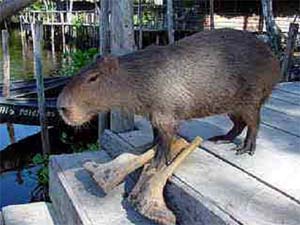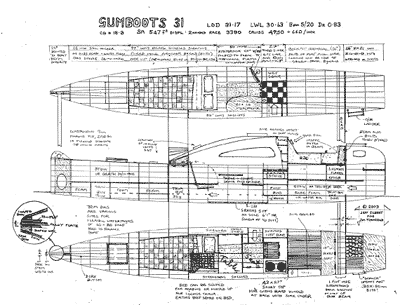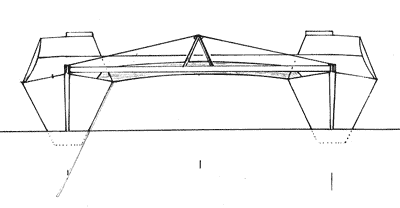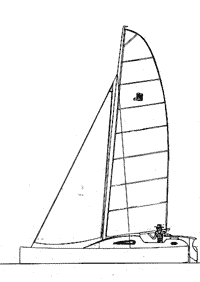|
This project contends that simplifying
the catamaran hull to 4 ply epoxy panels can produce a fully ocean
capable cruiser for an attainable price/build time combination.
It hopes to bring fast ocean travel to the wage earner.

Gumboots is a 31ft dory-hulled
performance cruiser with kicked up rear to a curved bottom at
the transom simply to ease the exit, which would have been a straight
line. Nose is dipped in slightly for directional stability but
will kiss the water if the boat is unloaded to a 2 man skeleton
(race) set-up at 3380 lbs. Entry is extremely fine with a fairly
bluff 2 inch bow which may be rounded, but the deck sheer plan
generates massive reserve bow buoyancy despite an absolute minimum
of ply torture/twist. All verticals from chine to sheer are straight.
Prismatic Coefficient is in the offshore range at 0.62 and hobby-horsing
is made virtually impossible by the wide rear.
The centre of buoyancy is calculated
twice by separate methods one a spreadsheet of construction, one
a spreadsheet of the loaded boat. In both cases it came out at
18.25 feet back from the stern, which is about where you stand
at the galley, luckily for the cook.
As the mast is both well rearward
and raked, the boats centres of action are all close to the cockpit
and it would be possible to operate the kick up lee daggers from
here using a winch and a couple of lines, but its easy enough
to hop up on the bridgedeck and drag the boards up or down, as
most of their weight is on the pivot. They will not be damaged
by a full speed beaching, or striking a whale etc.
The hull shape is the best compromise
I can manage of ease of build, and performance at a range of weights
which will see the boat able to compete two-handed with an upwind
Bruce Number of 1.57 and cruise loaded with 4 crew and a months
water at 1.37. Water is stored in 10g bags around the hull, enabling
fine-tuning of trim as the galley header tank in the cockpit coaming
is topped up. A reliable program indicates 250nm in racing mode
and 208nm covered in a seaway in 24hours, and while the boat is
no dragster, Id expect bursts in the high teens without any heroics.

click to enlarge
The 20-foot beam ensures reefing
down won’t be necessary until the boat is travelling uncomfortably
fast. Not directly comparable with any boat past or present, the
nearest would be to imagine one of the Woods cruisers minus the
bridgedeck pod. The open bridgedeck is a safety element, but the
boat could be made a lot roomier by small pod and bridgedeck cockpit,
enabling the wide soled areas taken by the cockpits to be converted
into accommodation. There is both room and carrying capacity to
do this. However the build time is right out of scope for this
project, which is a deliberate attempt to see just how quickly
an efficient cat can be built.
To this end construction, which
should be indoors, is by female moulds spaced by the first 9mm
layer of the dory bottom itself. Two 32 x 4 ft 9mm ply panels
are slid down past the bottom, sitting flush with it at the point
of maximum draught, and passing it in slots ford and aft. With
the moulds levelled properly and the ten-inch rocker checked,
the chines are filled inside with thickened epoxy and the few
permanent bulkheads filleted in. This swiftly built 31 x 5 foot
hull is joined last at the stem, which is specified exactly and
is a sandwich with a 12mm alloy plate at the centre to provide
a fore beam strong enough to lift the entire boat. The open hull
can be fitted out to suit the builder, and the suggested cabin
height altered as desired to give headroom in the saloon and stateroom.
Jim Townsend’s boat has a shower in the stateroom entry,
which governs the headroom. As no sole is needed (a wooden grate
is suggested) full HR is easily achieved (6.3ft in drawing). However
for cruising in heavy conditions a simple water ballast system
may be added beneath a sealed sole.
The hull can be raised in slings and turned to finish the bottom
(cut off excess sides, one final ply layer and glassed to above
WL). Or the hull can be simply rolled over inside 2 circular-cut
moulds. Or pushed over on mattresses. Many will prefer to do this
before finishing the cabin, it matters not, as the overall weight
is well under 1000 lbs at this stage.
The moulds are reused for the second
hull, and the beams check fitted before this is finally done on
a launch beach. The bridgedeck features a central beam enabling
some variation in the mast position – thus the builder can
save much by using a second hand rig.

The open bridgedeck is surrounded
by an 18 inch wall formed by cabin and beams, and the boom is
set very low enabling a large (547sq ft) sail area with a simple
to tack blade jib and just a 41ft small section 3 wire rotating
semi-wing mast to be self-built in cedar strip and glass, or built
from a semi-oval section available at an overall weight of 73.2
kg. The w ooden
wing would be somewhat lighter. This rather unusual rig is still
being discussed, but this designer is all for it for simplicity,
beauty, and lack of overall air draft. ooden
wing would be somewhat lighter. This rather unusual rig is still
being discussed, but this designer is all for it for simplicity,
beauty, and lack of overall air draft.
Prototype construction in Adelaide
at the experienced hands of Jim Townsend is expected to commence
early in 2004, when I return from a 3-month spell of retirement
house building in Tasmania.
Any comments are of course welcome,
but as I wont have the opportunity to reply till February, please
be patient. All correspondence will be replied to eventually.
Jeff Gilbert
jgilbert@webone.com.au.
|

